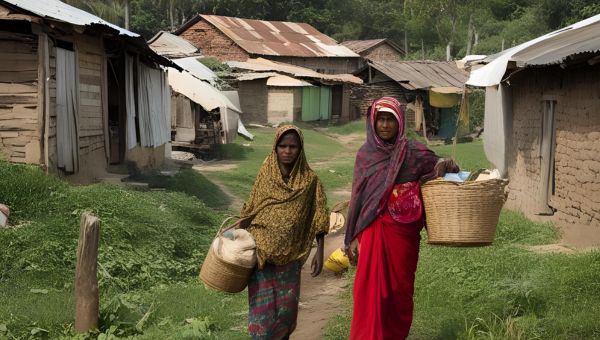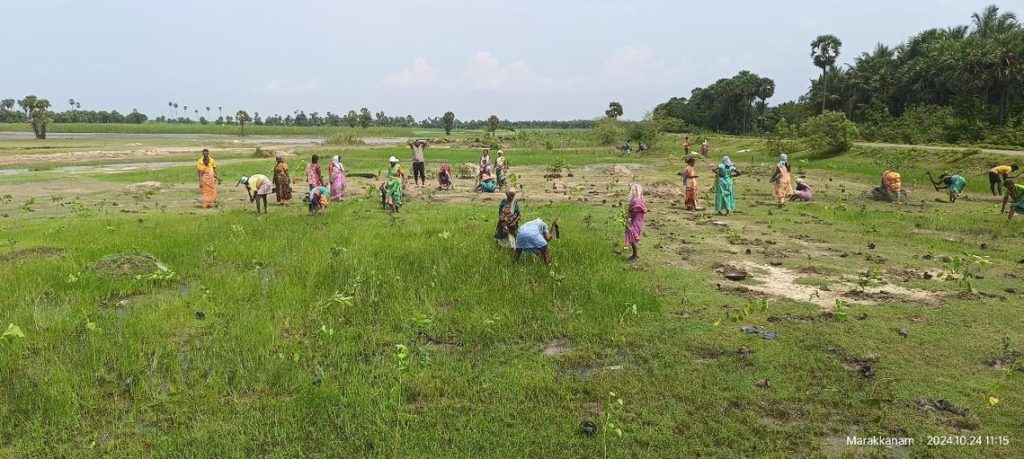Views
178

In the sun-drenched silence of Aathikuppam, a small village nestled in Andhra Pradesh, the winds carry more than just dust, they bring stories. Stories of women whove quietly withstood poverty, families braving natures wrath, and birds that once filled the skies but now arrive in dwindling numbers. Aathikuppam may seem inconspicuous on the map, but it stands at the crossroads of ecological fragility and human resilience.
Years ago, flocks of Spot-billed Pelicans and Painted Storks would descend from Siberia to the nearby Telineelapuram sanctuary, their calls echoing through the mangroves and farmlands. Today, their numbers have plummeted, from nearly 10,000 to a mere 1,000. Habitat loss, land degradation, and the recurring fury of cyclones have uprooted not just trees but entire ecosystems. In 2013, over 1,000 birds were killed when Cyclone Phailin tore through the Srikakulam district. Another storm, Titli, left a wake of broken nests and silent skies.
This is where the Trees for Migratory Birds™ project takes root.

Launched as a dual-purpose initiative, the project seeks to restore vital green cover for avian visitors while offering employment to the regions vulnerable communities. Its an act of healing, both ecological and economic. Trees like Tamarind, Neem, Jamun, and Peepal are planted not only to regenerate the land but also to provide shelter, food, and nesting sites for these migratory species. Their roots bind the soil, slow down runoff during heavy rains, and raise the groundwater table, quietly fighting back against the disasters that have become routine here.
Yet, these trees are doing something else, too. Theyre whispering hope into the lives of women like Subbulakshmi, Deeba, Gandhimathi, Malathi, and Parameswari. For them, this isnt just a plantation project. Its a lifeline. Come lets here what they have to say!
Subbulakshmi’s Silent Struggle

V. Subbulakshmi, 43, lives in a cramped rental hut with her husband, Vinayagamoorthi, and three children. Her husbands daily wages as a laborer barely sustain them. I had to take up any work I could find, she says. When the Trees for Migratory Birds™ project offered her a chance to earn, it brought a moment of stillness in her turbulent life. The wages we received were crucial for our survival, she adds. It meant her family could afford basic meals. For someone without a fallback, the project was more than work, it was stability.
Deeb’s Daily Battle

At 39, Deeba balances the household, two children, and the constant anxiety of her husbands uncertain paddy field income. When she began watering and monitoring the young saplings near her home, it didnt just provide an income. It brought money we desperately needed, she recalls. Each drop of water she poured onto a sapling felt like an investment in her childrens future.
Gandhimathis Hope for the Future

Gandhimathi, 44, has known the grind of rural hardship. Her husband, Loganathen, is also a daily wage worker. For Gandhimathi, joining the plantation work was not just about money, it was about reclaiming agency. The earnings helped her support her childrens education and ensure they didnt go to bed hungry. It helped us when we needed it the most, she says with quiet pride.
MaLathi’s New Beginnings

Malathi, 34, lives in a small hut with her husband Thachinamoorthy and three children. Their lives, too, teetered on the edge of survival. The wages were a great help, Malathi says, remembering the many nights of uncertainty. Each tree she planted became a symbol of resilience, rooted in struggle but growing toward a better tomorrow.
Parameswaris Strength

For Parameswari, 38, every day was a balancing act, raising children, caring for elderly parents, and managing her husband Veerasamys sporadic agricultural income. When she joined the plantation project, her burdens lightened. The income was a great help, she shares. It offered her dignity, control, and a renewed sense of purpose.
The Quiet Power of a Tree

To a passerby, these may appear as mere saplings swaying in the wind. But in Aathikuppam, each tree carries a deeper meaning. They are markers of renewal, the slow return of migratory birds, the healing of soil once eroded, and the rising hope in households long burdened by uncertainty.
The Trees for Migratory Birds™ project goes beyond planting trees. It restores balance, between people and nature, survival and stability. It transforms silent struggles into stories of resilience, where women become stewards of the land and protectors of their families futures.
What began as an ecological effort has grown into a shared journey of regeneration. It offers more than seasonal work, it offers agency, stability, and the quiet pride of building something lasting. In every green shoot, there is a promise, not just of a better tomorrow, but of a community that refuses to be forgotten.
And as the winds rustle through the leaves once again, they no longer carry only the silence of loss. They echo with birdsong, with laughter, and with the voices of women rewriting what it means to grow, together.
This World Migratory Bird Day, plant a tree, not just for the birds finding their way home, but for the women rebuilding theirs.
For more info, visit- Grow-Trees.com
Subscribe to our newsletter and recieve a selection of our cool articles every week.

When Mumbai’s Morning Haze No Longer Feels Like Home
Mumbai Weather Update: AQI Turns Severe as Thick Haze Persists, Free Press Journal (FPJ).
Nov 24, 2025

Delhi Is Gasping Again, And This Time, Even the Clouds Refused to Help
Delhi is choking again. AQI levels have slipped into the ‘severe’ zone, cloud seeding failed, and emergency measures barely make a dent. Because the city doesn’t need one-off fixes, it needs long-term healing. Trees remain the simplest, most effective answer. They absorb carbon, trap dust, cool the air, and act as natural lungs. If Delhi wants cleaner winters, it needs more green cover, not just temporary interventions. Clouds may not cooperate, but trees always will.
Nov 17, 2025
Copyrights @ 2025 All rights reserved by Pangea EcoNetAssets Pvt Ltd.